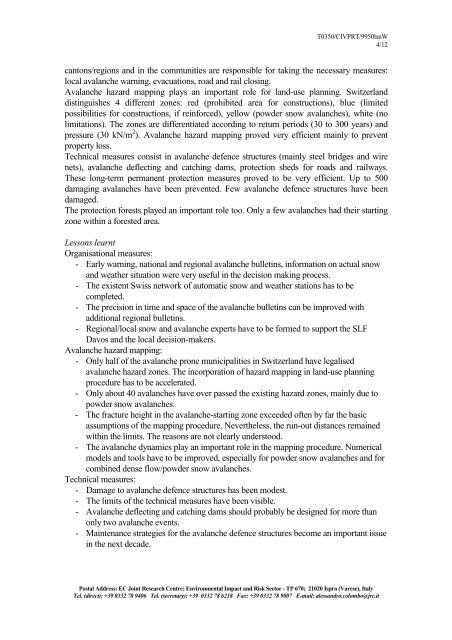lessons learnt from avalanche disasters - PreventionWeb
lessons learnt from avalanche disasters - PreventionWeb
lessons learnt from avalanche disasters - PreventionWeb
You also want an ePaper? Increase the reach of your titles
YUMPU automatically turns print PDFs into web optimized ePapers that Google loves.
T0350/CIVPRT/9950lsnW<br />
4/12<br />
cantons/regions and in the communities are responsible for taking the necessary measures:<br />
local <strong>avalanche</strong> warning, evacuations, road and rail closing.<br />
Avalanche hazard mapping plays an important role for land-use planning. Switzerland<br />
distinguishes 4 different zones: red (prohibited area for constructions), blue (limited<br />
possibilities for constructions, if reinforced), yellow (powder snow <strong>avalanche</strong>s), white (no<br />
limitations). The zones are differentiated according to return periods (30 to 300 years) and<br />
pressure (30 kN/m 2 ). Avalanche hazard mapping proved very efficient mainly to prevent<br />
property loss.<br />
Technical measures consist in <strong>avalanche</strong> defence structures (mainly steel bridges and wire<br />
nets), <strong>avalanche</strong> deflecting and catching dams, protection sheds for roads and railways.<br />
These long-term permanent protection measures proved to be very efficient. Up to 500<br />
damaging <strong>avalanche</strong>s have been prevented. Few <strong>avalanche</strong> defence structures have been<br />
damaged.<br />
The protection forests played an important role too. Only a few <strong>avalanche</strong>s had their starting<br />
zone within a forested area.<br />
Lessons <strong>learnt</strong><br />
Organisational measures:<br />
- Early warning, national and regional <strong>avalanche</strong> bulletins, information on actual snow<br />
and weather situation were very useful in the decision making process.<br />
- The existent Swiss network of automatic snow and weather stations has to be<br />
completed.<br />
- The precision in time and space of the <strong>avalanche</strong> bulletins can be improved with<br />
additional regional bulletins.<br />
- Regional/local snow and <strong>avalanche</strong> experts have to be formed to support the SLF<br />
Davos and the local decision-makers.<br />
Avalanche hazard mapping:<br />
- Only half of the <strong>avalanche</strong> prone municipalities in Switzerland have legalised<br />
<strong>avalanche</strong> hazard zones. The incorporation of hazard mapping in land-use planning<br />
procedure has to be accelerated.<br />
- Only about 40 <strong>avalanche</strong>s have over passed the existing hazard zones, mainly due to<br />
powder snow <strong>avalanche</strong>s.<br />
- The fracture height in the <strong>avalanche</strong>-starting zone exceeded often by far the basic<br />
assumptions of the mapping procedure. Nevertheless, the run-out distances remained<br />
within the limits. The reasons are not clearly understood.<br />
- The <strong>avalanche</strong> dynamics play an important role in the mapping procedure. Numerical<br />
models and tools have to be improved, especially for powder snow <strong>avalanche</strong>s and for<br />
combined dense flow/powder snow <strong>avalanche</strong>s.<br />
Technical measures:<br />
- Damage to <strong>avalanche</strong> defence structures has been modest.<br />
- The limits of the technical measures have been visible.<br />
- Avalanche deflecting and catching dams should probably be designed for more than<br />
only two <strong>avalanche</strong> events.<br />
- Maintenance strategies for the <strong>avalanche</strong> defence structures become an important issue<br />
in the next decade.<br />
Postal Address: EC Joint Research Centre; Environmental Impact and Risk Sector - TP 670; 21020 Ispra (Varese), Italy<br />
Tel. (direct): +39 0332 78 9406 Tel. (secretary): +39 0332 78 6218 Fax: +39 0332 78 9007 E-mail: alessandro.colombo@jrc.it












![View full document [PDF 988.55 KB] - PreventionWeb](https://img.yumpu.com/47733942/1/184x260/view-full-document-pdf-98855-kb-preventionweb.jpg?quality=85)
![View full document (in French) [PDF 4.96 MB] - PreventionWeb](https://img.yumpu.com/47223870/1/184x260/view-full-document-in-french-pdf-496-mb-preventionweb.jpg?quality=85)


![View full document [PDF 25.02 MB] - PreventionWeb](https://img.yumpu.com/44204570/1/190x234/view-full-document-pdf-2502-mb-preventionweb.jpg?quality=85)
